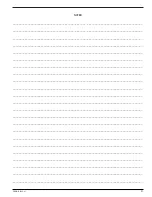
L4463
(
rev
.
c
)
19
Troubleshooting Chart
Symptom
Possible Cause
Solution
1. Pump will not start.
a. Compressed air system turned off
or air supply line blocked.
Turn on compressed air system. Verify that gauge on
pump air filter/regulator indicates pressure.
b. Low air pressure and/or flow.
Increase air pressure as required. Verify that compressed
air system is capable of producing the minimum required
pressure and flow. Refer to Section 3.1.
c. Air logic control valve malfunction. Check for proper operation of the air logic control valve.
Replace if required.
d. Mechanical damage to pump
element and/or air motor.
Troubleshoot pump air motor and pump element
components to determine cause. Check pendant controls
and air lines.
2. Pump stops under load.
a. Low air pressure.
or
Minimum required air flow rate is
insufficient.
Increase air pressure as required.
Use a larger diameter air supply line and/or adequate air
source.
b. Air muffler clogged by ice or dirt.
Check air muffler exhaust vent. Remove ice if present.
Replace air muffler elements if clogged. Refer to air
muffler manufacturer’s instructions and parts lists.
c. Pump bypass valve out of
adjustment or malfunctioning.
Readjust or repair pump bypass valve.
d. Mechanical damage to pump
element and/or air motor.
Troubleshoot pump air motor and pump element
components to determine cause.
3. Pump fails to build
pressure or builds less
than full pressure.
a. User-adjustable relief valve open
or set too low.
Increase relief valve pressure setting. Refer to Section 8.5.
b. Air in the hydraulic system.
Perform air removal procedure. Refer to Section 8.4.
c. External leak in the hydraulic
system.
Check entire hydraulic system for leaks. Tighten, repair or
replace components as required.
d. Oil needs changing.
Pump oil intake filter clogged.
Drain, clean and inspect the hydraulic reservoir per
instructions in Sections 9.1 and 9.2. Remove any dirt or
sludge. Clean or replace the oil intake filter.
e. Internal leak in hydraulic control
valve or pump element. Worn or
damaged internal components.
Troubleshoot hydraulic control valve and pump element
components. Tighten, repair or replace components as
required.
4. Low oil flow.
a. Low air pressure and/or flow.
Increase air pressure as required. Verify that compressed
air system is capable of producing the minimum required
pressure and flow. Refer to Section 6.4.
b. Dirty air filter element.
Replace filter element inside the air filter/lubricator. Refer
to filter/lubricator manufacturer’s instructions and parts
lists.
c. Internal leak in hydraulic control
valve or pump. Worn or damaged
internal components.
Troubleshoot hydraulic control valve and pump element
components. Tighten, repair or replace components as
required.
d. Oil needs changing.
Pump oil intake filter clogged.
Drain, clean and inspect the hydraulic reservoir per
instructions in Section 9.1 and Section 9.2. Remove any
dirt or sludge. Clean or replace the oil intake filter.
(continued on next page)
10.0
TROUBLESHOOTING
Only qualified hydraulic maintenance personnel with appropriate skills and training should be permitted to service the
pump or system components. The
Troubleshooting Chart
is not all inclusive but is intended to be used as a guide to
help diagnose and resolve the most common problems which may occur.






































